With permutations, the order of the selected items matters. If
the order of items selected into a subset does not matter, we have combinations.
The number of combinations of ![]() distinct items taken
distinct items taken ![]() at a
time (order doesn’t matter) is:
at a
time (order doesn’t matter) is:
![]()
![]() is called “
is called “![]() choose
choose ![]() ”.
”.
Note that the number of combinations
is an application of an overcounting correction: We are arranging ![]() objects,
of which
objects,
of which ![]() objects are alike and
the rest
objects are alike and
the rest ![]() objects are alike.
objects are alike.
![]() is to choosing
is to choosing ![]() items into
a group from
items into
a group from ![]() items. It is equivalent
to choosing
items. It is equivalent
to choosing ![]() items into another group
from
items into another group
from ![]() items. Therefore,
items. Therefore, ![]() . We can easily prove the
identity using the formula as well:
. We can easily prove the
identity using the formula as well:
![]()
One inference from the number of combinations is that the
product of any ![]() consecutive integers
is divisible by
consecutive integers
is divisible by ![]()
Problem 3‑14
Powerball: What is the probability of winning Powerball if you buy a Powerball ticket? Powerball is a multi-state lottery[11] offered in most of the United States. The game sequentially randomly draws 5 balls from 69 balls labeled from 1 to 69 without replacement and then draws a separate Powerball from 26 balls labeled from 1 to 26. A lottery buyer chooses five numbers from 1 to 69 and then selects a Powerball number from 1 to 26. If both the set of five numbers (orders do not matter) and the Power number match the drawings, the ticket wins the Powerball.
Solution: The number of possible outcomes of drawing 5 balls from 69 balls labeled from 1 to 69 is a combination. The number of combinations can be calculated as
![]()
The number of possible outcomes of drawing the Powerball is
26. Since these two steps are independent, the total number of possible
outcomes is ![]()
Therefore, the probability of winning the Powerball is 1/292201338.
Problem 3‑15
In how many ways can the letters in the word BANANA be arranged?
Solution:
This is the same as Problem 3‑12. Let’s solve the same problem using
combinations. The word BANANA has 6 letters: 3 As, 2Ns, and 1 B. We need to put
these letters into 6 “seats.” First, we choose the seats for A. We need to
choose 3 seats from 6 seats. Since As are indistinguishable, the orders do not
matter. Therefore, the number of combinations is ![]() Among the remaining 3
seats, we need to choose 2 for Ns. The number of combinations is
Among the remaining 3
seats, we need to choose 2 for Ns. The number of combinations is ![]() Applying the basic principle
of counting, the total number of ways is
Applying the basic principle
of counting, the total number of ways is ![]()
The combination approach shows that the link between permutation
and combination is the principle of overcounting. Because the order of the k
selected items does not matter in a combination, it is equivalent to that the items
are indistinguishable. Therefore, we correct the overcounting by dividing the
number from permutation by ![]()
Problem 3‑16
How many ways can you put 3 white rooks (assuming they are
indistinguishable) on an ![]() chessboard so that no
two rooks share the same row or column?
chessboard so that no
two rooks share the same row or column?
Solution:
We can put the first rook in any of the 64 squares, which eliminates one row
and one column from the board as the rest of the rooks cannot be in the same
row or column. After eliminating one row and one column, the chessboard becomes
a ![]() one. Thus, the second
rook has 49 choices. The second rook eliminates another row and another column
and leaves a
one. Thus, the second
rook has 49 choices. The second rook eliminates another row and another column
and leaves a ![]() chessboard. Therefore,
the total permutation is
chessboard. Therefore,
the total permutation is ![]() Since the rooks are
indistinguishable, we need to divide the number by
Since the rooks are
indistinguishable, we need to divide the number by ![]() The
total number of ways is
The
total number of ways is ![]()
Problem 3‑17
Part A. How many ways are there to distribute 10 apples
to 4 children? Assume that each child may get ![]() to 10 apples.
to 10 apples.
Part B. If we assume that each child needs to get at least 1 apple, how many ways are there to distribute 10 apples to 4 children?
Solution:
As shown in Figure 3‑4, if we put the 10 apples in a row on a table,
distributing the apples to 4 children is equivalent to putting 3 dividers to
separate the apples to 4 piles. Since a pile may have 0 apples, it means a
divider may be to the left or right of all apples, and two dividers may be
between the same two apples. The example in Figure 3‑4 divides the apples
to piles of ![]() apples. We have 13
positions. 10 of the positions are allocated to the apples and the remaining 3
to dividers. It is equivalent to choosing a subset of 3 objects out of a total
of 13 objects. Therefore, the number of ways to distribute 10 apples to 4
children is
apples. We have 13
positions. 10 of the positions are allocated to the apples and the remaining 3
to dividers. It is equivalent to choosing a subset of 3 objects out of a total
of 13 objects. Therefore, the number of ways to distribute 10 apples to 4
children is ![]()
![]()
![]() .
.
![]()
Figure 3‑4 Distributing items among groups
In part B, since each child needs to get at least 1 apple, we
can first distribute 1 apple to each child. Then the problem becomes how many
ways there are to distribute 6 apples to 4 children, assuming that each child
may get 0 apples. Following part A’s logic, we get the solution ![]()
![]()
![]() .
.
Let’s consider another approach to solve part B that offers a
different perspective. We still need 3 dividers to divide 10 apples. Since each
pile cannot have 0 apple, we cannot put a divider to the left or the right of
all apples. We cannot have two dividers between the same two apples either, as
that will create a pile with 0 apples. As shown in Figure 3‑5, we need to
choose ![]() dividers among the
dividers among the ![]() spaces
that separate the 10 apples.
spaces
that separate the 10 apples.
Therefore, the solution is ![]() .
.
![]()
Figure 3‑5 Distributing items among non-empty groups
General
Rule: If we need to count the number of ways to distribute ![]() items among
items among ![]() groups and each group
may get 0 objects, the problem is equivalent to choosing
groups and each group
may get 0 objects, the problem is equivalent to choosing ![]() dividers among
dividers among ![]() places for dividers and
objects. Therefore, the solution is
places for dividers and
objects. Therefore, the solution is ![]() .
.
If we
need to count the number of ways to distribute ![]() items among
items among ![]() groups and each group
must have at least 1 object, the problem is equivalent to choosing
groups and each group
must have at least 1 object, the problem is equivalent to choosing ![]() dividers among
dividers among ![]() possible places.
Therefore, the solution is
possible places.
Therefore, the solution is ![]()
Problem 3‑18
Part A. ![]() and
and ![]() are
nonnegative integers that satisfy
are
nonnegative integers that satisfy ![]() In how many ways can we
create such groups of
In how many ways can we
create such groups of ![]() and
and ![]() ?
?
Part B. Sophie is putting together a Halloween treat bag that contains 10 pieces of Hershey’s nuggets from three types of nuggets: milk chocolate, milk chocolate with almonds, and dark chocolate. How many different combinations are possible?
Solution:
Both parts of this problem are equivalent to distributing 10 items among three groups (![]() and
and ![]() ), and
each group may get 0 objects. Therefore, there are 66 ways.
), and
each group may get 0 objects. Therefore, there are 66 ways.
General
Rule: When we encounter problems that allow the number of items in each group
to vary, think about recognizing or converting the problem to a problem of
distributing ![]() items among
items among ![]() groups.
groups.
We will
see another problem equivalent to distributing ![]() items
among
items
among ![]() groups when we calculate
the number of terms in multivariate polynomials.
groups when we calculate
the number of terms in multivariate polynomials.
Problem 3‑19
If we assume that each child gets no more than 5 apples, how many ways are there to distribute 10 apples to 4 children?
Solution:
The problem is easier to solve if we use complementary counting. Without
restriction, the total number of choices is ![]() . Let’s consider the
cases that one child does get more than 5 apples. In such cases, we first set
aside 6 apples and give them to one of the kids. Since there are 4 apples left,
that selected kid is the only one who has more than 5 apples and there are 4
choices of which kid to get the 6 apples set aside. Then we distribute the
remaining
. Let’s consider the
cases that one child does get more than 5 apples. In such cases, we first set
aside 6 apples and give them to one of the kids. Since there are 4 apples left,
that selected kid is the only one who has more than 5 apples and there are 4
choices of which kid to get the 6 apples set aside. Then we distribute the
remaining ![]() apples to 4 children.
The number of choices of the second step is
apples to 4 children.
The number of choices of the second step is ![]() . The number of choices where
at least one child gets more than 5 apples is
. The number of choices where
at least one child gets more than 5 apples is ![]() Therefore,
the number of ways to distribute 10 apples to 4 children without anyone getting
more than 5 apples is
Therefore,
the number of ways to distribute 10 apples to 4 children without anyone getting
more than 5 apples is ![]() .
.
Problem 3‑20
The Greenwich High School basketball team has 10 team members. The team needs to select five members to play in a basketball game. John and James are brothers who always play together. In other words, if one of the brothers is selected to play the game, the other brother must also be selected. How many possible ways are there to select a team?
Solution: Since special rules apply to John and James, let’s use the casework approach by considering different scenarios involving the selection of John and James. For each scenario, we estimate the possible ways to select a team. Because John and James can only be selected together, there are two possible cases:
Case 1. Both John and James are selected, in which case we
select 3 members from the other 8 team members. There are ![]()
![]()
![]() possible
combinations.
possible
combinations.
Case 2. Neither John nor James is selected, in which case we
select 5 members from the other 8 team members. There are ![]()
![]()
![]() possible
combinations.
possible
combinations.
Therefore, the total number of ways is ![]()
Problem 3‑21
The Greenwich High School basketball team has 10 team members. The team needs to select five members to play in a basketball game. John and James are brothers. Since their parents are on a business trip, at least one of them needs to stay at home to babysit their kid sister. In other words, if one of the brothers is selected to play the game, the other cannot be selected. How many possible ways are there to select a team?
Solution: Since special rules apply to John and James, let’s again consider different scenarios involving the selection of John and James. For each scenario, we estimate the possible ways to select a team. Because John and James cannot be selected together, there are three possible scenarios:
Scenario 1. John is selected and James is not, in which case
we need to select 4 members from the other 8 members. There are ![]() possible combinations.
possible combinations.
Scenario 2. James is selected and John is not. There are ![]() possible combinations as
well.
possible combinations as
well.
Scenario 3. Neither John nor James is selected. There are ![]() possible combinations.
possible combinations.
Therefore, the total number of ways is ![]()
A different approach to solve the problem is
to use complementary counting. If there is no restriction, the number of ways
to choose a team is ![]()
![]()
![]() . Since John and James cannot be both selected for the team,
we only need to exclude the cases that they are both selected. As discussed
in the previous problem, there are
. Since John and James cannot be both selected for the team,
we only need to exclude the cases that they are both selected. As discussed
in the previous problem, there are ![]()
![]()
![]() possible
combinations that they are both selected. Therefore, the number of ways is
possible
combinations that they are both selected. Therefore, the number of ways is![]() .
.
Complementary counting can be applied to the previous problem
as well. We again start with 252 combinations if there is no restriction. Since
John and James can only be selected together, we need to exclude two scenarios:
John is selected and James is not; James is selected and John is not. In this
problem, we have shown that either case has ![]() possible combinations.
Therefore, the solution for the previous problem is
possible combinations.
Therefore, the solution for the previous problem is ![]()
Problem 3‑22
How many rectangles are in Figure 3‑6? A rectangle may
be of different sizes ranges from ![]() to
to ![]() in
the figure.
in
the figure.
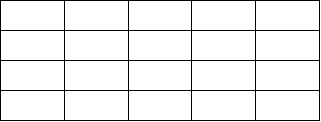
Figure 3‑6 Question: Number of rectangles
Solution:
If we think in terms of the smallest rectangles as the building block, there
are ![]() smallest rectangles. One
way to solve the problem is to use casework by considering different sizes of
the rectangle that we select. Let
smallest rectangles. One
way to solve the problem is to use casework by considering different sizes of
the rectangle that we select. Let ![]() be the height
be the height ![]() and
and ![]() be the
width
be the
width ![]() We can build a table to
track the number of rectangles of different sizes:
We can build a table to
track the number of rectangles of different sizes:

What’s the grand total? We can sum the totals
by row or by column. Both give us the same result, ![]() Following this analysis,
we also see a general rule for the total number of rectangles: If the largest
rectangle includes
Following this analysis,
we also see a general rule for the total number of rectangles: If the largest
rectangle includes ![]() small rectangles, the
number of rectangles of all sizes are
small rectangles, the
number of rectangles of all sizes are ![]()
![]()
Now let’s consider a different and more intuitive approach
(once we understand the logic behind it). Rectangles are formed by the
intersection of two horizontal lines and two vertical lines. A pair of
horizontal lines and a pair of vertical lines identify a unique rectangle. As
shown in Figure 3‑7, the number of horizontal lines to choose is ![]() (more
generally
(more
generally ![]() ), and the number of
vertical lines to choose is
), and the number of
vertical lines to choose is ![]() (more generally
(more generally ![]() ). For
example, choosing horizontal lines
). For
example, choosing horizontal lines ![]() and vertical lines
and vertical lines ![]() form
the shaded
form
the shaded ![]() rectangle. To form a
rectangle, we choose any of two (unordered) horizontal lines and two vertical
lines independently. The number of choices for two horizontal lines is
rectangle. To form a
rectangle, we choose any of two (unordered) horizontal lines and two vertical
lines independently. The number of choices for two horizontal lines is ![]() and the number of
choices for two vertical lines is
and the number of
choices for two vertical lines is ![]() . Therefore, the total
number of rectangles is
. Therefore, the total
number of rectangles is ![]() .
.
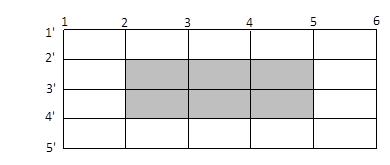
Figure 3‑7 Solution: Number of rectangles
General Rule: If the rectangle
includes ![]() small rectangles, the
number of rectangles of all sizes are
small rectangles, the
number of rectangles of all sizes are ![]() =
=![]()
Problem 3‑23
As shown in Figure 3‑8, a ![]() grid
is made of 25
grid
is made of 25 ![]() small squares. How many
squares are in Figure 3‑8? A square may be of different sizes ranges from
small squares. How many
squares are in Figure 3‑8? A square may be of different sizes ranges from
![]() to
to ![]() in the
figure.
in the
figure.
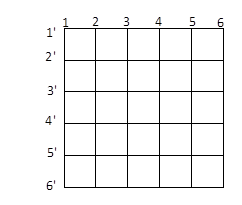
Figure 3‑8
Number of squares in a ![]() grid
grid
Solution: Let’s start with square(s) of size ![]() There
is only one choice: horizontal lines
There
is only one choice: horizontal lines ![]() and
and ![]() are
selected, and vertical lines
are
selected, and vertical lines ![]() and
and ![]() are
selected. For squares of size
are
selected. For squares of size ![]() there are 2 choices for
horizontal line groups
there are 2 choices for
horizontal line groups ![]() and 2 choices for
vertical line groups
and 2 choices for
vertical line groups ![]() The total number of
combinations is
The total number of
combinations is ![]() Similarly, for squares
of size
Similarly, for squares
of size ![]() there are
there are ![]() combinations. For
squares of size
combinations. For
squares of size ![]() there are
there are ![]() combinations. For
squares with of size
combinations. For
squares with of size ![]() there are
there are ![]() combinations. Therefore,
the total number of squares is
combinations. Therefore,
the total number of squares is ![]()
General
Rule: For a ![]() square grid, the
total number of squares of different sizes is
square grid, the
total number of squares of different sizes is ![]()
Problem 3‑24
How many possible ways are there to select three numbers from
integers ![]() (orders do not matter)
so that their product is an even number?
(orders do not matter)
so that their product is an even number?
Solution: If there is no restriction, there are ![]() combinations. For their
product to be an even number, there are three scenarios: 1 out of 3 is even; 2
out of 3 are even; 3 out of 3 are even. Instead of calculating each scenario
and adding them up, we can exclude the ways to make the product to be an odd
number from
combinations. For their
product to be an even number, there are three scenarios: 1 out of 3 is even; 2
out of 3 are even; 3 out of 3 are even. Instead of calculating each scenario
and adding them up, we can exclude the ways to make the product to be an odd
number from ![]() . The product of three
numbers is odd if and only if all three numbers are odd, which means that we
need to choose all three numbers from 50 odd numbers between 1 and 100 (
. The product of three
numbers is odd if and only if all three numbers are odd, which means that we
need to choose all three numbers from 50 odd numbers between 1 and 100 (![]() ). The
number of combinations to choose three numbers from 50 odd number is
). The
number of combinations to choose three numbers from 50 odd number is ![]()
![]()
![]() .
Therefore, the number of ways to select three numbers so that their product is
an even number is
.
Therefore, the number of ways to select three numbers so that their product is
an even number is ![]() .
.
Problem 3‑25
Jason’s home (point A in Figure 3‑9) is 6 blocks west and 3 blocks south of the school (point B). Every day he walks along the bocks to get to school. If his route is as short as possible, how many different routes can he take?
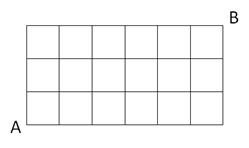
Figure 3‑9 Number of paths to school
Solution:
The shortest route always includes 9 blocks: 3 blocks north and 6 blocks east.
Therefore, the number of routes is simply choosing 3 blocks to go north out of
9 blocks: ![]()
Problem 3‑26
Stephen’s home (point A in Figure 3‑10) is 7 blocks west
and 7 blocks south of the school (point B). Every day he walks along the blocks
to get to school. Because a large building occupies a ![]() blocks,
he can only walk along the path shown in Figure 3‑10. If his route is as
short as possible, how many different routes can he take?
blocks,
he can only walk along the path shown in Figure 3‑10. If his route is as
short as possible, how many different routes can he take?
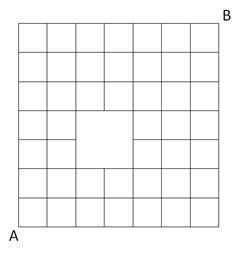
Figure 3‑10 Number of paths to school with blocked paths
Solution: The problem appears to be complex at first glance. The building creates a hole in the grid and makes the shape of the available blocks irregular. If we use a casework approach, we need to consider different scenarios on how a path first reaches the building. A much simpler approach is to add the streets removed by the building back, count the number of paths that include those “nonexistent” streets, and subtract the number from the total number of paths if the building were not there.
Following the last question’s logic, the total number of paths
without the building is ![]() As shown in Figure 3‑11, to count the number of paths that include those “nonexistent”
streets, the key is to recognize that all such paths include point C (the
center of the building). Point C separates the paths to
As shown in Figure 3‑11, to count the number of paths that include those “nonexistent”
streets, the key is to recognize that all such paths include point C (the
center of the building). Point C separates the paths to ![]() ,
which is a
,
which is a ![]() grid with
grid with ![]() combinations, and
combinations, and ![]() ,
which is
,
which is ![]() grid with
grid with ![]() combinations. Therefore,
the total number of paths to exclude is
combinations. Therefore,
the total number of paths to exclude is ![]() and the number of valid
paths is
and the number of valid
paths is ![]()
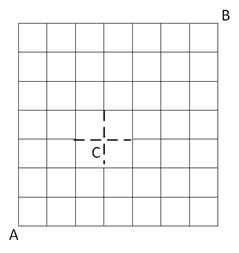
Figure 3‑11 Solution: Number of paths to school with blocked paths
Problem 3‑27
««« Screwy pirates: A group of 11 pirates gathers together to put all the loot in a safe. Being a democratic bunch, they decide that only a majority – any majority – of them (≥6) together can open the safe. So they ask a locksmith to put a certain number of locks on the safe. To access the treasure, every lock needs to be opened. Each lock can have multiple keys, but each key only opens one lock. The locksmith can give more than one key to each pirate.
What is the smallest number of locks needed? And how many keys must each pirate carry?[12]
Solution: This problem
is a good example of the application of combinatorial analysis in information
sharing and cryptography. Let’s randomly select 5 pirates from the 11-member
group; there must be a lock that none of them has the key to. Yet any of the
other 6 pirates must have the key to this lock since any 6 pirates can open all
locks. In other words, we must have a “special” lock to which none of the 5
selected pirates has a key, and the other 6 pirates all have keys. Such
5-pirate groups are chosen randomly. Thus, for each combination of 5 pirates,
there must be such a “special” lock. The minimum number of locks needed is  locks.
locks.
Each lock has
6 keys, which are given to a unique 6-member subgroup. Therefore, each pirate
must have ![]()
![]() keys.
That’s surely a lot of locks to put on a safe, and a lot of keys for each
pirate to carry.
keys.
That’s surely a lot of locks to put on a safe, and a lot of keys for each
pirate to carry.
[11] In 2018, Americans spent more than $70 billion on lottery tickets. That’s more than $300 per adult.
[12] Hint: Every subgroup of 6 pirates should have the same key to a unique lock that the other 5 pirates do not have.